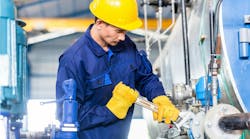Efficient, reliable material handling is essential for a well-functioning warehouse. Still, it tends to lag behind other processes in terms of tech transformation, and it’s time for that to change. Introducing AI in material handling—particularly in the area of predictive maintenance—can yield significant improvements.
Despite not being as extensively automated as other workflows, material handling still involves a lot of equipment. This machinery requires reliable maintenance strategies to deliver more value over a longer period, and this is where many organizations miss strategic opportunities. Applying predictive maintenance and expanding this practice’s benefits through broader AI adoption can give warehouses a competitive edge in a fast-evolving industry.
The Need for Better Maintenance in Material Handling
Warehouse managers must first understand the need for material handling predictive maintenance to recognize the benefits of upgrading it with AI. More than half of all industrial facilities use a run-to-failure maintenance method. This leads to significant downtime, which is costly.
Repairing a machine is expensive. However, the true cost of downtime in material handling goes far beyond these direct expenses. When machines aren’t moving material, downstream supply chain operations must also slow down or pause. This creates a ripple effect of delays and lost productivity.
Even more worryingly, 70% of workplace injuries occur during reactive maintenance. Consequently, significant breakdowns may also leave warehouses with employee safety and injury-related costs to worry about. These can lead to ongoing losses if an injury keeps workers from working efficiently for some time.
Preventive maintenance prevents some of these costs and downtime, but many preventive measures don’t add any value. Technicians end up “fixing” issues that aren’t causing any problems. Consequently, schedule-based repair strategies introduce unnecessarily high maintenance timelines and expenses.
The Predictive Maintenance Difference
Predictive maintenance in material handling offers a more cost-effective solution. This strategy starts with monitoring equipment health factors in real-time through Internet of Things (IoT) sensors. AI models analyze this data to determine when current conditions suggest a machine will need repairs before long.
These AI algorithms then alert relevant stakeholders of the emerging problem so they can schedule a time to fix the machine. Consequently, material handling workflows can address maintenance concerns before they cause breakdowns or other larger problems. At the same time, they prevent unnecessary downtime from unneeded inspections and repairs.
Predictive maintenance often yields the most equipment uptime and long-term cost savings of any repair strategy. Much of that stems from how early these warnings are. AI can detect issues before they’re even noticeable to humans, letting businesses fix them while they’re as small and affordable as possible.
Similarly, because these repairs are condition-based, any time and money spent on maintenance goes directly to material improvements. Consequently, it’s more cost-effective in the long run despite technologies like the IoT and AI costing more upfront.
Pushing Predictive Maintenance Further With AI
Predictive maintenance is a promising example of the power of AI in material handling. However, businesses can go further. More extensive AI implementation can lead to compounding benefits, making predictive maintenance even more effective.
It starts by defining the conditions that indicate the need for repair. Predictive warnings only save time and money if they accurately reflect future maintenance needs. Consequently, warehouses first need to set specific guidelines for acceptable conditions. AI can make this process faster and more reliable.
Different material handling equipment and replacement parts have varying maintenance requirements. Bearings made of high-percentage VIM-VAR steel, for example, produce minimal bearing strain, so they don’t need replacement as often as alternatives. AI can recognize these unique needs and factor them into its calculations when determining acceptable machine parameters.
Natural language processing (NLP) models can add further insight by scanning OEM recommendations to pull more information about acceptable conditions. These same algorithms can also analyze customer reviews of equipment to highlight common problems. All this data informs more accurate maintenance predictions.
Applying AI after implementing predictive maintenance in material handling can help, too. Machine learning models can analyze repair histories and past predictions to find trends like frequent issues or moments when predictions were incorrect. Warehouses can use this insight to know when to replace some machines instead of repairing them or how to adjust predictive models for improved accuracy.
Common Problems and Solutions
As warehouse managers approach these technologies, they should keep a few common problems in mind. Any cutting-edge technology carries unique risks along with its benefits, so it’s important to implement them carefully to minimize disruption and maximize results.
Right-sizing maintenance solutions to specific processes is an important step in making the most of these technologies. Predictive maintenance is highly effective in machines with predictable breakdown patterns and when companies have enough available data. Without those prerequisites, though, it can lead to more downtime—counteracting savings—because of high false positive rates.
Material handling facilities should keep those constraints in mind when planning their maintenance strategies. Equipment with less data available and less regular wear patterns may be better off with a non-predictive condition-based maintenance approach.
Analyzing past repair and breakdown data with AI may make it easier to identify ideal predictive maintenance use cases. It’s similarly important to train predictive models on machine-specific data to make them as accurate as possible.
Applying AI in material handling can also be expensive. Applying these technologies on a small scale before slowly expanding is the best way forward. Facilities can begin with whichever machine is in most need of improvement. The resulting ROI will likely come faster and be larger, enabling more effective scaling from there.
Finally, organizations must upskill their workforce. Roughly 68% of executives today report a moderate-to-extreme AI skills gap, which makes it difficult to use these tools effectively. Enrolling current workers in AI training courses and training warehouse employees to adjust to new, AI-driven workflows will help overcome that barrier.
Capitalize on AI in Material Handling Today
AI in material handling isn’t as widespread as it is in some other industrial sectors, and that’s a missed opportunity. This technology can be a potential game-changer for many warehouses, especially when it comes to predictive maintenance.
All predictive maintenance strategies require AI, but leaning further into this technology takes these benefits higher. While difficulties remain, organizations can see marked improvements by combining these technologies in their material handling workflows.









